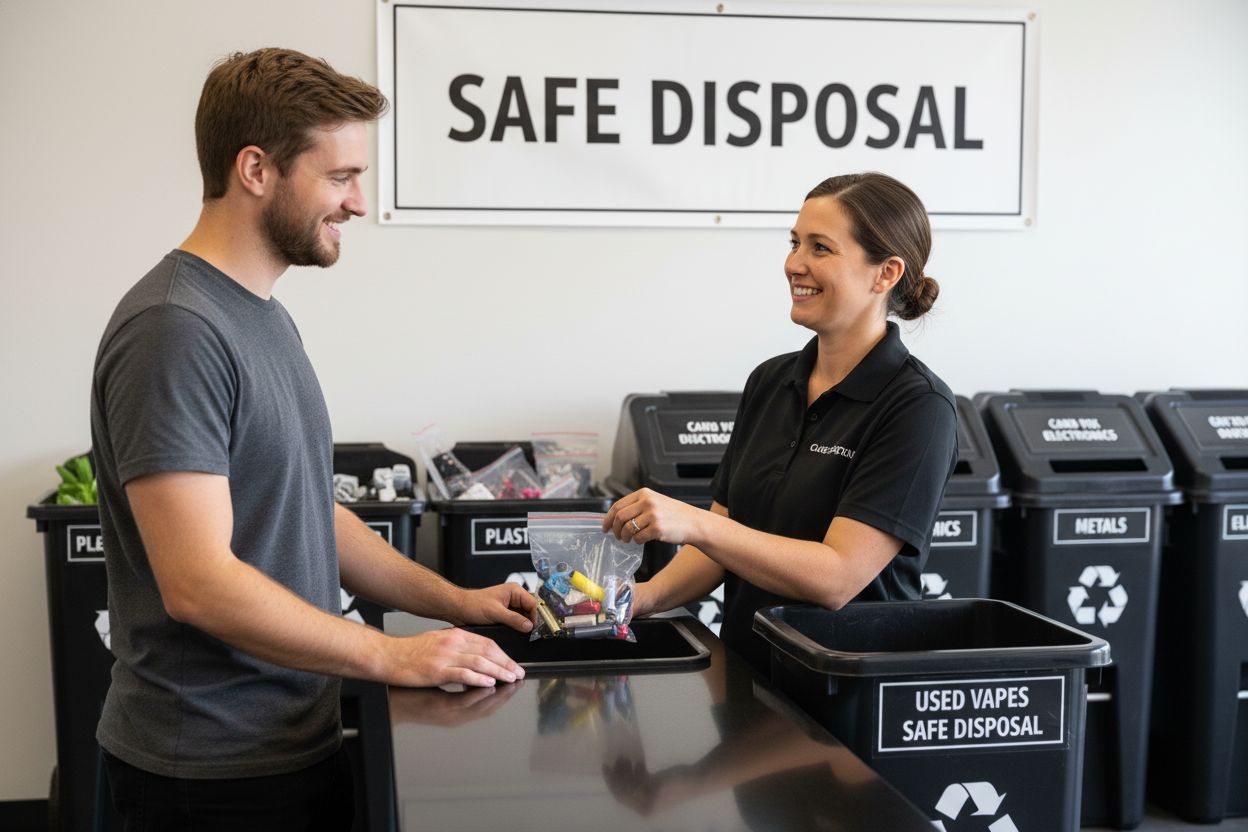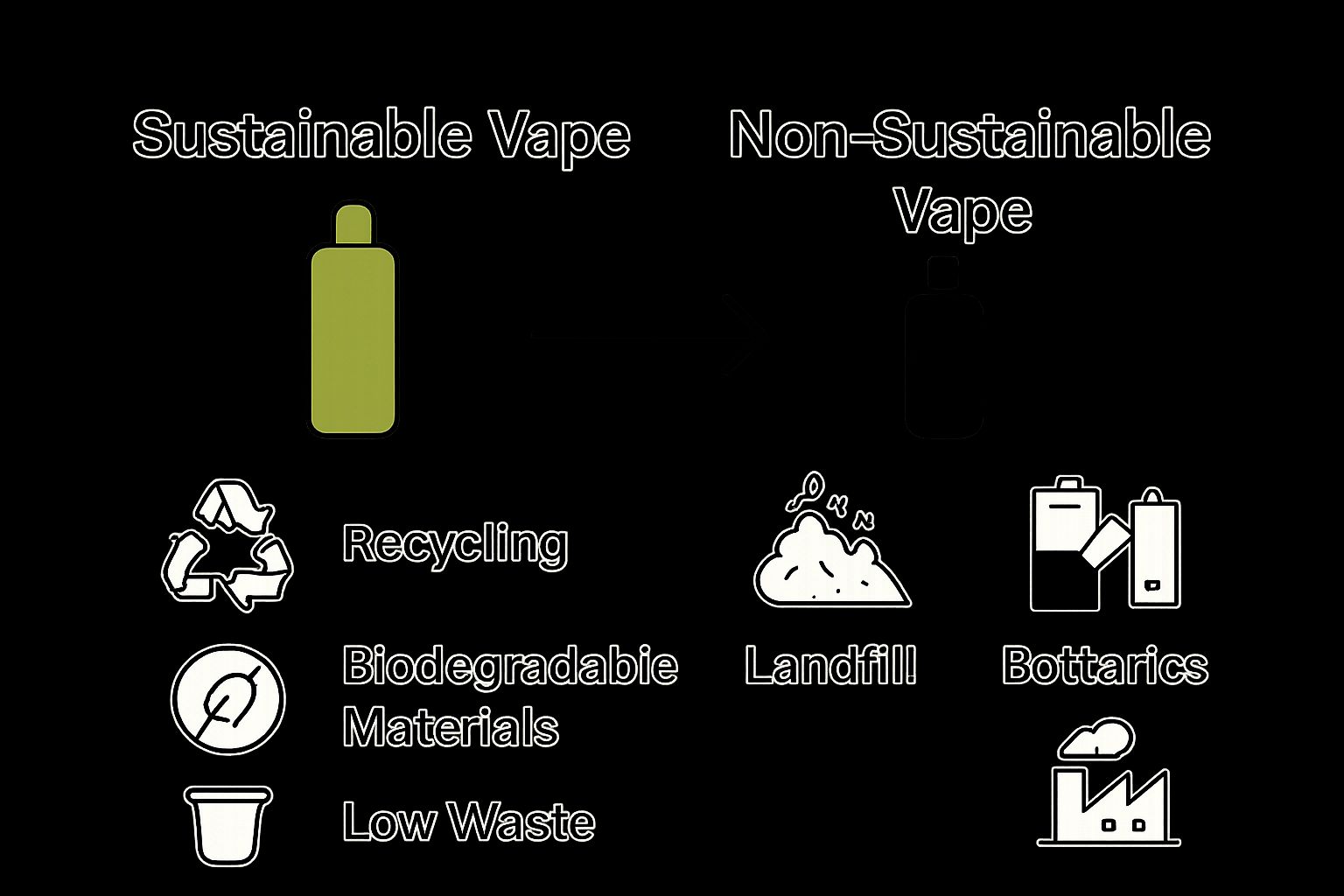Blog
Understanding Why is Vape Sustainability Important
Vape products are everywhere and they are leaving a huge mark on the planet. Nearly every disposable vape device contains multiple non-biodegradable materials and chemical residues that can contaminate soil and water for decades. Most people think vaping is just about personal choice or flavor, but the real story goes much deeper. The big issue is how these devices impact the environment long after you toss them out.
Table of Contents
- What Is Vape Sustainability?
- The Importance Of Sustainable Practices In Vaping
- Environmental Impact Of Vape Products
- Health Considerations Related To Vape Sustainability
- Future Trends In Sustainable Vaping
Quick Summary
| Takeaway | Explanation |
|---|---|
| Emphasize recyclable materials in vape production | Using recyclable or biodegradable materials reduces waste impact and supports sustainability efforts in the vaping industry. |
| Educate consumers on responsible disposal | Proper disposal methods for vape products help mitigate environmental contamination and promote ecological responsibility. |
| Invest in modular and rechargeable designs | Modular designs and rechargeable models can significantly decrease electronic waste and extend product lifespans. |
| Support innovative recycling programs | Robust recycling initiatives for electronic vaping components are essential in minimizing the carbon footprint associated with disposed devices. |
| Collaborate for sustainable practices | Manufacturers, consumers, and regulatory bodies must work together to create a more sustainable vaping environment through shared responsibility. |
What is Vape Sustainability?
Vape sustainability represents a comprehensive approach to minimizing the environmental impact of vaping products throughout their entire lifecycle. According to research from the National Institutes of Health, sustainable vaping considers critical factors beyond mere consumption, focusing on responsible manufacturing, usage, and disposal practices.
Environmental Considerations in Vaping
Sustainable vaping encompasses multiple dimensions of ecological responsibility. These include reducing waste generation, minimizing carbon footprint, and developing strategies for product recycling and responsible disposal. Key considerations involve examining the materials used in vape manufacturing, the energy consumed during production, and the long term environmental consequences of disposable vaping devices.
Key elements of vape sustainability include:
- Utilizing recyclable or biodegradable materials in device construction
- Implementing responsible manufacturing processes that reduce energy consumption
- Developing robust recycling programs for electronic vaping components
- Creating devices with longer operational lifespans
- Supporting consumer education about proper disposal methods
Technological and Design Innovations
The future of sustainable vaping relies heavily on technological innovations that prioritize environmental consciousness. Manufacturers are increasingly developing recyclable vape products that minimize waste and maximize resource efficiency. These innovations include developing devices with rechargeable batteries, using more sustainable materials, and creating modular designs that allow for component replacement rather than entire device disposal.
By integrating sustainability into every stage of product development and consumption, the vaping industry can significantly reduce its environmental footprint while maintaining product quality and user experience.
The Importance of Sustainable Practices in Vaping
Sustainable practices in vaping have emerged as a critical environmental and public responsibility strategy. According to research from the British Medical Journal, the proliferation of disposable vaping products generates significant waste that demands immediate and comprehensive intervention.
Environmental Impact and Waste Management
The environmental consequences of traditional vaping practices are profound. Each disposable vape device represents a complex waste challenge, containing multiple materials that are challenging to recycle. Electronic components, lithium batteries, plastic casings, and chemical residues create substantial environmental strain when improperly discarded. Sustainable practices aim to mitigate these negative consequences by transforming how vaping products are designed, consumed, and ultimately disposed of.
The following table summarizes the main environmental risks and corresponding sustainable practices discussed in the article. Use this table to quickly compare how each risk is addressed through sustainability efforts.
| Environmental Risk | Description | Recommended Sustainable Practice |
|---|---|---|
| Electronic waste accumulation | Non-biodegradable devices and components build up in landfills | Use recyclable materials and participate in recycling programs |
| Soil and water contamination | Chemical residues and battery leakage pollute ecosystems | Educate on responsible disposal and safe recycling |
| Harmful compound release | Batteries and electronics can leak toxins | Develop safer manufacturing and disposal processes |
| Resource depletion | Manufacturing uses plastics, metals, and energy | Invest in energy-efficient, modular, and rechargeable designs |
| Increased carbon footprint | Frequent device production adds to emissions | Use longer-lasting products and advanced recycling efforts |
Key environmental risks associated with unsustainable vaping include:
- Accumulation of non-biodegradable electronic waste
- Potential contamination of soil and water systems
- Release of harmful chemical compounds
- Unnecessary depletion of manufacturing resources
- Increased carbon footprint from frequent device production
Consumer and Industry Responsibility
Addressing vape sustainability requires collaborative efforts from manufacturers, consumers, and regulatory bodies. Safe disposal practices represent a crucial component of this multifaceted approach. Manufacturers must prioritize designing products with recyclable materials, while consumers need education about responsible disposal methods.
 This holistic strategy transforms vaping from a potential environmental liability into a more responsible consumer experience.
This holistic strategy transforms vaping from a potential environmental liability into a more responsible consumer experience.
By embracing sustainable practices, the vaping industry can significantly reduce its environmental footprint, demonstrating a commitment to ecological stewardship and responsible product design. The future of vaping depends not just on technological innovation, but on a comprehensive understanding of our environmental interconnectedness.
Environmental Impact of Vape Products
Vape products generate significant environmental challenges that extend far beyond their immediate usage. According to research from the National Center for Biotechnology Information, the cumulative ecological footprint of disposable vaping devices represents a growing concern for waste management and environmental sustainability.
Material Composition and Waste Generation
Disposable vape products are complex assemblages of materials that create substantial waste streams. Electronic components, lithium batteries, plastic casings, and chemical residues combine to form intricate environmental challenges. Each device typically contains multiple non-biodegradable elements that resist standard recycling processes, leading to long term environmental contamination.
Key material challenges in vape product waste include:

- Lithium battery components with potential heavy metal contamination
- Plastic casings that require hundreds of years to decompose
- Electronic circuits containing rare earth metals
- Chemical residues from vaping liquid reservoirs
- Mixed material compositions that complicate recycling efforts
Carbon Footprint and Resource Consumption
The production and disposal of vape products contribute significantly to carbon emissions and resource depletion. Manufacturing processes require substantial energy expenditure, while frequent device replacement generates unnecessary waste. Disposable vape recycling represents a critical strategy for mitigating these environmental consequences.
Manufacturers and consumers must recognize that each discarded vape device represents not just waste, but a complex environmental burden. By understanding the intricate ecological implications of vaping product lifecycles, stakeholders can develop more responsible consumption and disposal strategies that minimize environmental degradation.
Health Considerations Related to Vape Sustainability
Health sustainability in vaping extends beyond individual consumption to broader public health implications. According to research from the National Institutes of Health, improper disposal and manufacturing of vaping products can introduce significant health risks to communities and individual users.
Chemical Exposure and Toxicity Risks
Sustainable vaping practices directly correlate with minimizing potential health hazards. Vape devices contain complex chemical compositions that can release harmful substances during production, usage, and disposal. Electronic components, battery materials, and liquid reservoirs potentially introduce toxic compounds into environmental and human biological systems. These risks are amplified when devices are improperly manufactured or discarded.
Potential health risks associated with unsustainable vaping include:
- Potential heavy metal contamination from electronic components
- Chemical leaching from improperly disposed devices
- Nicotine residue exposure in waste management environments
- Potential respiratory irritants from manufacturing processes
- Long term environmental contamination risks
Public Health and Environmental Interconnection
The relationship between vaping sustainability and public health is deeply interconnected. Current usage trends demonstrate that responsible product design and disposal can significantly mitigate potential health risks. Manufacturers must prioritize creating devices that minimize chemical leaching, reduce toxic material usage, and provide clear guidance for safe disposal.
By understanding the complex health implications of vaping product lifecycles, consumers and manufacturers can collaboratively develop more responsible practices that protect both individual and community health. Sustainable approaches represent not just an environmental imperative, but a crucial public health strategy.
Future Trends in Sustainable Vaping
The vaping industry is undergoing significant transformative shifts towards sustainability, driven by environmental consciousness and technological innovation. According to research from the Tobacco Free Kids Organization, emerging trends are reshaping how manufacturers approach product design and lifecycle management.
Technological Innovations in Sustainable Design
Advanced material science and engineering are revolutionizing vape product sustainability. Manufacturers are exploring biodegradable components, modular designs that enable easier repair and component replacement, and advanced recycling technologies. These innovations aim to dramatically reduce electronic waste and minimize the environmental footprint of vaping devices.
Key technological sustainability trends include:
- Development of fully recyclable electronic components
- Biodegradable battery and casing materials
- Modular design allowing individual part replacement
- Advanced battery recycling technologies
- Integration of renewable energy charging systems
Consumer Education and Industry Responsibility
The future of sustainable vaping hinges on collaborative efforts between manufacturers, consumers, and regulatory bodies. Understanding vaping usage trends reveals a growing consumer demand for environmentally responsible products. Manufacturers must prioritize transparent communication about product sustainability, offering clear guidance on responsible usage and disposal.
Embracing sustainable practices represents more than an environmental strategy it is a comprehensive approach to reimagining product lifecycles. By integrating innovative design, responsible manufacturing, and consumer education, the vaping industry can transform its ecological impact and set new standards for technological sustainability.
This table presents key technological innovations and design features that contribute to vape sustainability. It helps highlight how various approaches reduce environmental impact throughout the product lifecycle.
| Innovation/Design Feature | How It Enhances Sustainability |
|---|---|
| Recyclable electronic components | Makes devices easier to process once disposed |
| Biodegradable battery materials | Reduces electronic and toxic waste in landfills |
| Modular/replaceable designs | Extends product lifespan and lowers overall waste generated |
| Advanced battery recycling tech | Minimizes risks from battery leakage and promotes reuse |
| Renewable energy charging systems | Decreases carbon footprint during device use and recharging |
Make Sustainable Vaping Your Reality With Shorties Disposable
Are you frustrated with the environmental impact of traditional vape products and worried about what happens to your device after use? The article highlights major concerns like waste accumulation, hazardous chemical leakage, and the lack of responsible disposal options. Your search for greener, safer cannabis vaping is valid and urgent—vape sustainability truly matters.

Choose a smarter path with Shorties Disposable. Our high-capacity, live-resin vape devices are designed for lower environmental impact while still delivering premium, potent experiences. We are committed to lab-tested quality, transparent product information, and a dedicated recycling program to help you dispose responsibly. Make the switch to a brand that values sustainability as much as you do. Visit our site today and take your next step toward eco-friendly cannabis vaping.
Frequently Asked Questions
What is vape sustainability?
Vape sustainability refers to minimizing the environmental impact of vaping products throughout their lifecycle, focusing on responsible manufacturing, usage, and disposal.
Why is sustainable vaping important for the environment?
Sustainable vaping is crucial as it addresses issues like waste generation, carbon footprint, and the environmental consequences of disposable vaping devices, helping to reduce pollution and conserve resources.
How can manufacturers contribute to vape sustainability?
Manufacturers can contribute by using recyclable or biodegradable materials, implementing energy-efficient production processes, and developing robust recycling programs for electronic components.
What health risks are associated with unsustainable vaping practices?
Unsustainable vaping practices can lead to chemical exposure and toxicity risks, including heavy metal contamination and chemical leaching, which can adversely affect both environmental and public health.
Recommended
- What is Disposable Vape Recycling and Why It Matters – SHORTIES DISPOSABLE VAPE
- What is Safe Disposal Vape? Understanding Responsible Practices – SHORTIES DISPOSABLE VAPE
- Understanding Vape Usage Trends 2025: Key Insights – SHORTIES DISPOSABLE VAPE
- Understanding What Are Recyclable Vape Products – SHORTIES DISPOSABLE VAPE

